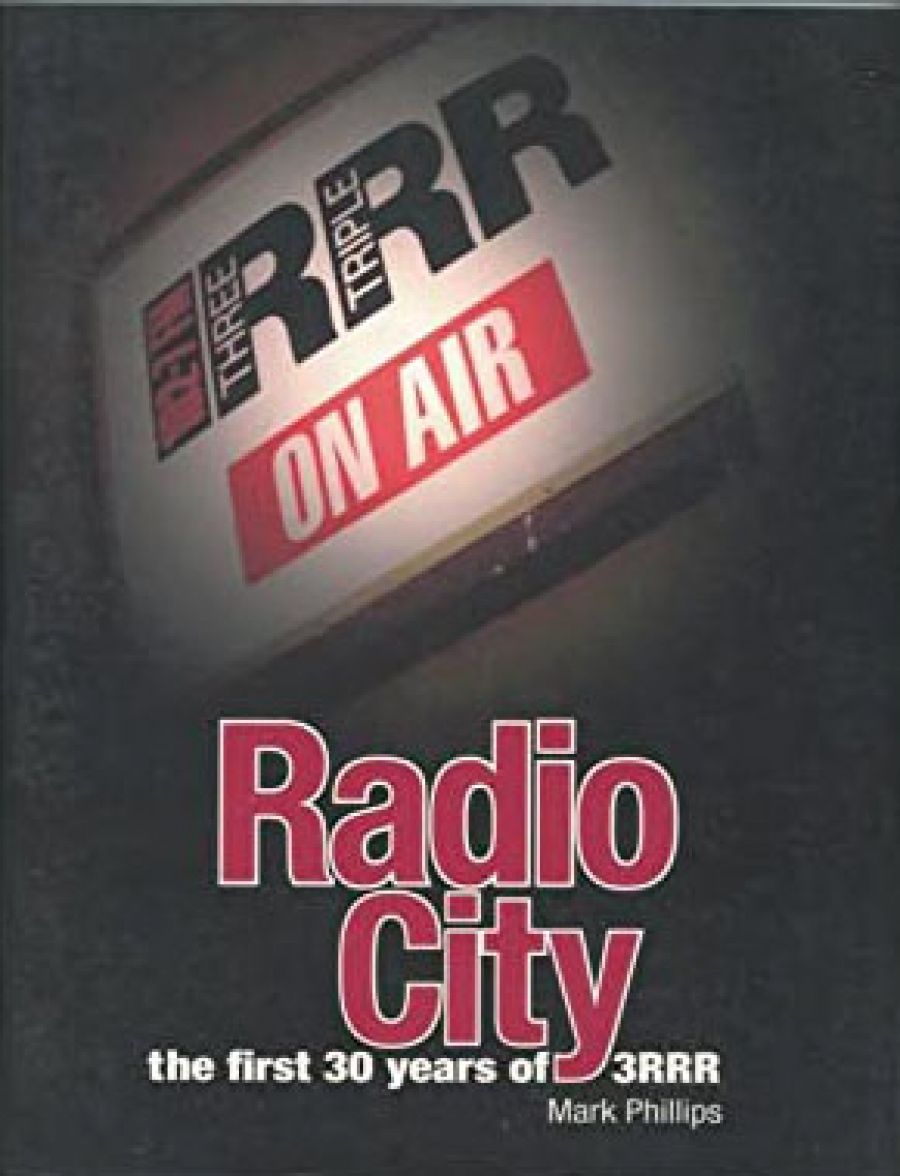
- Free Article: No
- Contents Category: Media
- Review Article: Yes
- Article Title: Local Icon
- Online Only: No
- Custom Highlight Text:
1980: a red-haired girl in my Year Ten art class at John Gardiner High School asked me if I knew there was a radio station that only played ‘that new wave music’. She said it with a measure of contempt in her voice – for me and for it. But I was tempted, and soon became part of 3RRR’s small, staunch audience. A quarter of a century on comes Mark Phillips’s lively, if listy (though no more than Ken Inglis’s ABC histories) narrative of this Melbourne institution’s first thirty years.
- Book 1 Title: Radio City
- Book 1 Subtitle: The first 30 years of 3RRR
- Book 1 Biblio: Vulgar Press, $39.95 pb, 324 pp
It began in 1976 with an educational licence as 3RMT-FM, operating out of the Royal Melbourne Institute of Technology’s media studios, provided the aged transmitter wasn’t overheating or irate students weren’t forcing it off air. Moving off-campus into Carlton, it began to create new, original and controversial spoken word and music programming by clever hit-and-miss anti-methods.
The station was instrumental in bringing authoritative and informative women’s voices to radio in the 1970s, when such a thing was very rare; non Anglo announcers and, despite its reputation as the bastion of fashionista Fitzroy trendiness, outer-suburban perspectives were also strongly promoted. Additionally, for better or worse, 3RRR helped to shape the laconic, comedic tone which now dominates commercial FM in capital cities around the country. More importantly, a large proportion of rock’s current and past cognescenti has owed an inestimable debt to 3RRR’s role as tastemaker and groundbreaker (for instance, it was the only station in Australia to play Midnight Oil’s first album). Perhaps most impressively, 3RRR, with its small staff, regular financial disasters, extraordinary infighting and drama, is by far Australia’s most popular public radio station and consistently outrates Triple J in Melbourne. This might merely be explained away as Melbourne provincialism: it might also be a rare example of popularity indicating quality.
Freelance journalist Phillips’s history is celebrity-oriented and, perhaps unfairly, concentrates on the ‘success stories’: the most popular and long-running shows. Commercial radio stations have been luring volunteer announcers away from 3RRR to lucrative careers (or obscurity) for two decades now, a situation which only helps the station, inasmuch as it keeps talent turning over and heightens its ‘brand’. Additionally, Phillips, while readily acknowledging the role that women have played at 3RRR, is far more interested in blokey chat and humour, and the book’s focus is skewed in that direction. The author’s admiration for the one-time staff member and current volunteer broadcaster Stephen Walker, and his frequent description of Walker as a ‘guru’, is perhaps the least successful aspect of Radio City, particularly since Walker is revealed to be an undiplomatic political player in station staff–volunteer relations for much of the story.
Not surprisingly for a radio station so close to the grass roots, everyone at 3RRR gets his or her hands dirty. Burn-out is almost inevitable, star announcers often go out in blazing vitriol, and rages are maintained for decades. The best parts of Radio City’s narrative come when Phillips details the darker side of the station’s volatile dynamic, such as the dismissal in the late 1980s of popular volunteer announcer Paul Madigan for alleged racial vilification.
Phillips relies largely on media archives and contemporary interviews with key players (there is very little material from the broadcasts, and station archives are sketchy). Not unnaturally, the individuals he speaks to are eager to talk, and the author organises this material well. Where he sometimes falls down is on the context, both social and musical. His grasp of the station’s early days and of the kind of Melbourne in which it operated is flimsy. That he should also be so shaky on some musical matters is surprising: many 3RRR stalwarts, not just esoteric pedants, will shake their heads sorrowfully over Phillips’s confusing the Reels with the Reals (why is it important? Well, they’re entirely different bands, years apart) and other farcical claims: for instance, that the Teenage Radio Stars ‘changed their name’ to the Models. More broadly, the stated notion that the station was born on the back of punk and new wave is sorely tested by the fact that very little such music was available during the first few years of the station’s existence. These issues could have been addressed by enlightened editing, which might also have weeded out unusual terms such as ‘easybeats’, presumably intended to describe easygoing deadbeats.
Writing a history of something as intangible as radio is undoubtedly a rough task to set oneself; a history of a beloved local icon such as this is a minefield. Radio City will appeal mostly to 3RRR listeners – in the main, the text is as authoritative and smart as the station itself – and some casual readers may even be converted.


Comments powered by CComment